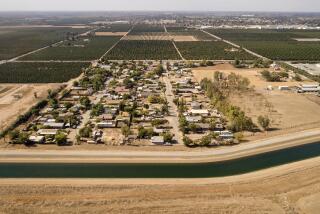A Drought of Water Revenues
- Share via
SANTA BARBARA — Let us first revisit the infamous painted lawns of Santa Barbara. It was 1990, the sixth year of a wicked drought. Isolated from the canals that carry water down from the northern mountains or across from the Colorado River, Santa Barbara and its coastal neighbors always had relied on rainfall for their water, and now the rains had stopped coming.
Consumption was ordered cut in half, and squads of “water cops” were dispatched into the streets to enforce rationing. Many homeowners drilled backyard wells, hoping to hit water. It was a time of low-flow toilets and desert landscaping and grander schemes. One dry town laid plans to ship fresh water down from Canada by tankers.
What gained the most attention, though, were the painted lawns. Forbidden to water their grass, residents turned to green vegetable dye. “After working hard all day,” explained the manager of a nursery, “some people don’t want to come home to a brown lawn.” It came to be seen, this lawn painting, as a pathetic last grasp at the flimsy illusion that Southern California is something other than a desert--the moral of the story, if you will, of the great drought.
The rains returned in 1991, and there has been plenty of water since. Nonetheless, chastened coastal residents have clung to the conservation ethic. Water consumption has not returned to pre-drought levels--a development which anywhere else would provide a pat and happy ending to a tale of natural hardship and human ingenuity. This, though, is a story of California water, and so on we go now to the great complication.
*
“It’s more like a soft sell,” the former water commissioner was explaining. “The blurbs we used to put in the newspaper and send home with the bills would say: ‘DON’T USE WATER!’ Now it’s more like, ‘Well, you always should use water wisely, but, hey, there is plenty of water.’ ”
Yes, it is happening. A region that was the centerpiece of one of California’s worst droughts, a place that proved just how far in crisis a relative puddle of water could be stretched, now finds itself in the absurd position of trying to force water down the throats of a resistant populace. Moratoriums on new meters have been canceled. Rate structures that once encouraged conservation have been reversed, so that now the rewards go to those who use more, not less, water.
Why? It goes back to those crazy days of drought, when no promise of new water seemed too far-fetched, too expensive. In a single election day, construction of a $36-million desalination plant for Santa Barbara and a $500-million pipeline to connect the region’s water agencies with the state aqueduct were approved by voters. Money was borrowed with the expectation that demand for water would surge after the drought passed. Greater usage would produce greater revenues--and pay down the debt.
“Well, we now have lots of water, but we still have all the debt,” said Bendy White, who as city water commissioner questioned the need for the long-disputed pipeline. “In the drought, everyone learned how to conserve. We installed tens of thousands of water-conserving toilets, shower heads; they’re still there. We planted millions of square feet of drought-tolerant landscape; it’s there to stay. And behavior patterns have not changed. People still turn off the water when they brush their teeth.”
*
And now has come a new panic. Public concerns about whether overextended water agencies can stay afloat have been raised. Lawsuits have been filed, calls for grand jury investigations issued. The darkest scenario envisions a domino-like bankruptcy rattling across the region; bleak comparisons to Orange County are not uncommon.
Some coastal water districts have jacked their rates higher and higher in a scramble to offset the shortfall--paradoxically risking further slumps in consumption levels. At least one town has closed down city services for one day a month, hoping to save money for the water project debt. Others have annexed land to spur new subdivisions that will raise demand for water--a strange way to manage growth. And Santa Barbara has mothballed its desalination plant.
And once again residents have been called upon to do their part, as they did so nobly in the drought. In not quite so many words, but with absolute clarity, the call has gone out. Flush that toilet, people, fill that swimming pool. Rip out those cacti and loiter in the shower all day long. Water that grass until it’s as green, well, as green as the greenest paint.
Madness? Yes. Surprising? Not really. Water in California always has been treated as currency, to be fought over and hoarded, bought and sold--consumed--at the going rate, and never shared. Such a system can only encourage consumption over conservation, grand dams and canals over the mellow yellow promise of low-flow toilets and the like. Except in a drought . . .







